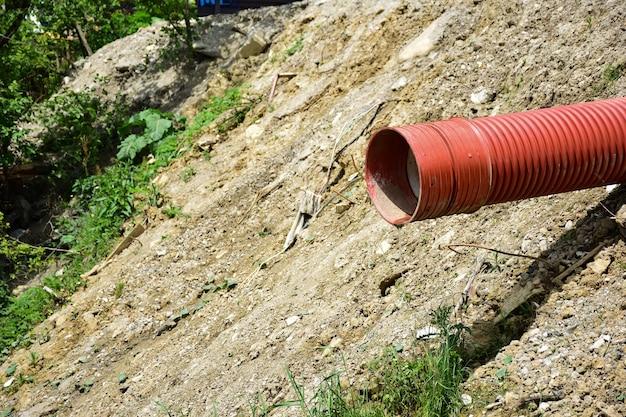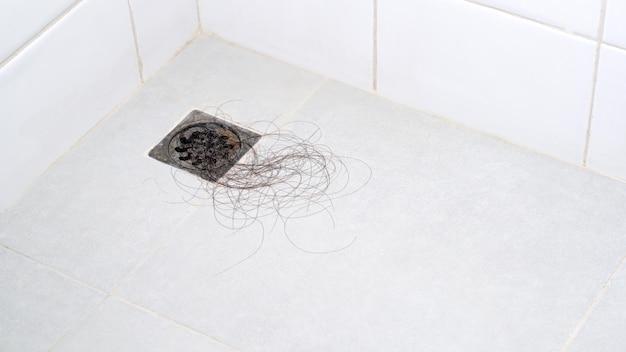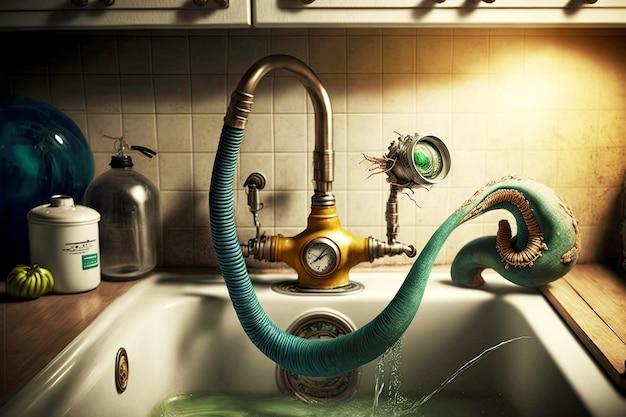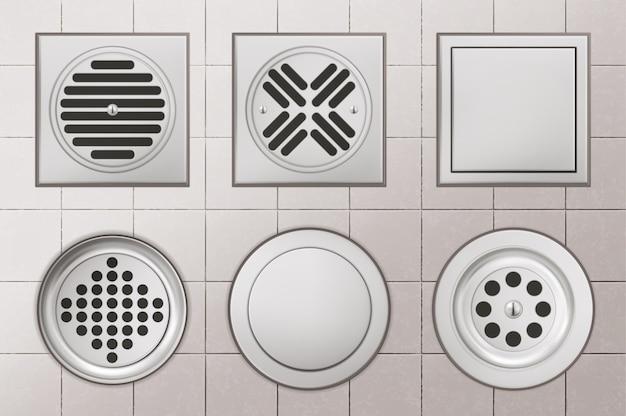Are you experiencing slow drainage issues with your septic system? It’s a frustrating problem that can disrupt your daily routine. If you’re wondering what’s causing the slow drain and how to fix it, you’ve come to the right place. In this blog post, we’ll discuss the possible reasons behind your slow drain septic system, signs of a clogged septic line, and the best solutions to clear it. Read on to learn how to keep your septic system in top shape and avoid costly repairs.
Slow Drains? Here’s What’s Going on with Your Septic System
Have you ever noticed that your drains are struggling to let water through? Do you find yourself thinking that your sink drains slower than a sloth? Chances are, your septic system is the culprit. But why is your septic system causing the slow drain problem?
The Causes of Slow Drain Septic System
A slow-draining septic system is certainly not the most endearing trait to have, but take solace: you’re not alone! Slow drains due to your septic tank can happen to anyone. It’s a common issue that most homeowners experience at some point. Here are some possible reasons behind the slow drain septic system:
Blockage
Blockages within the septic system are the primary culprit of slow-draining pipes. The build-up of solid waste, hairs, oils, and fats, flushed objects such as paper towels, feminine hygiene products, and other such waste can all lead to blockages.
Clogging
Have you been dumping all the greasy pans down your sink? Well, that’s your problem! Oils and fats clog up septic pipes. They cling onto the walls of the drain pipes and constrict the water’s flow. In cases of severe clogging, professional drain cleaning services might be needed.
Pumping
If you have been relying on a faulty septic tank pumping frequency, then you might witness slow drains more often than required. Septic tank pumping is essential, and an infrequency in doing so could lead the solids to accumulate in the tank, causing the water to drain more slowly than usual.
Prevention of Slow Drain Septic System
A slow drain septic system can be a hassle, but it’s not something you have to tolerate. Here are some of the preventive measures you can take to avoid slow drains due to your septic tank:
Schedule Regular Septic Tank Maintenance
Just like any other appliance in your house, the septic system requires regular maintenance. Regular septic tank pumping is crucial in avoiding slow-draining septic systems.
Garbage Disposal
Anything and everything that can potentially clog your pipes should not be flushed down the toilet or drains. Instead, ensure that you use a garbage disposal unit to dispose of such waste.
Consistent use of Enzyme-Based Cleaners
Using enzyme-based cleaners is an excellent preventive measure in keeping your septic system healthy and free of blockages.
Wrapping Up
Slow drains due to a septic tank can be a real pain in your neck, or legs (since you have to stand in water for so long!), luckily, it’s an entirely fixable problem. By performing regular maintenance, being mindful of what goes down your drain, and using enzyme-based cleaners, you can save yourself the headache of slow-draining pipes.
Signs of a Clogged Septic Line
Imagine taking a shower and standing in a pool of your own filth because the water won’t drain properly. Gross, right? Unfortunately, this is a common problem among homeowners with septic tanks, and it’s usually due to a clogged septic line. Here are some signs to look out for:
Slow Draining Fixtures
If you’ve noticed that water is taking forever to drain from your sink or shower, it’s a clear sign that your septic line is clogged. This happens when solid waste accumulates in the pipes, causing a blockage. If left unattended, it can lead to sewage backups and other unpleasant scents.
Foul Odors
Speaking of unpleasant smells, if you’ve been noticing a strong odor coming from your drains or yard, it’s a sign that your septic system needs attention. The odor comes from the accumulation of waste in the pipes, which is then released into the air. This is not only gross but also a health hazard for you and your family.
Patchy Grass
If you notice that the grass above your septic tank is looking greener and more lush than the rest of your lawn, it’s a sign that something’s not right. It means that the waste is not being absorbed into the soil, and it’s instead seeping out of the ground. Not only is this an eyesore, but it’s also a sign of a major septic problem.
Gurgling Noises
If you hear gurgling noises coming from your toilet or sink, it’s a sign that air is trapped in your septic line, which is trying to escape. This happens when waste is blocking the pipes, and it’s not allowing air to flow freely through the system. The noise is not only annoying but also a warning sign that something’s clogged in your septic line.
Overflowing Septic Tank
If your septic tank is overflowing or filling up faster than usual, it’s a clear sign that it’s clogged. This means that the waste is not being properly disposed of, and it’s causing a backup in your septic system. If left unattended, it can lead to sewage backups and other unpleasant issues.
In conclusion, knowing the signs of a clogged septic line can save you a lot of time, money, and headache. If you notice any of the above signs, it’s important to address the issue immediately to avoid more significant problems. Consider hiring a professional to inspect your septic system regularly and keep it in good working condition. Trust me, your nose, and your wallet will thank you!
Slow Drain Septic System Problems
Has your slow drain septic system become an everyday headache? Do you have to wait for hours for the water to drain in your sink or have a shower? If you answered yes, then you know the struggle of dealing with a slow drain system.
Let’s take a look at some of the problems caused by slow drain septic systems.
Unappealing Odors
When water doesn’t drain fast enough, odors originating from the septic system will build up in your house. Sadly, this is a common problem with slow drain septic systems, and it can create an uninviting atmosphere in your home.
Bacterial Buildup
Slow drains limit the water flow in your septic system, leading to bacterial buildup. When you have bacteria growing in your septic tank, a costly and smelly disaster is on the horizon. No one wants to pay for an expensive septic tank backup!
Soggy Yard Syndrome
When your septic system isn’t draining as efficiently as it should, you will observe ‘soggy Yard Syndrome. ‘ This issue is caused by the sewage overflow in your septic tank, which makes it too heavy to contain. It could result in water surfaces in your yard or even worse, the water could find its way back into your home.
Septic System Failure
If the slow drain issue goes unnoticed and left unattended, the entire septic system could fail. And, believe me, you don’t want to experience such an ordeal. A septic system that fails could cause costly damage to your home, and the repair costs are astronomical.
In conclusion, a slow drain septic system affects your home’s comfort and could cause damage leading to costly plumbing repairs. Don’t wait until it’s too late; seek professional help if you observe a slow drain today!
Septic Tank Not Draining to Field
So, you woke up one morning, all energized and ready to conquer the day, only to be greeted by one of the most annoying problems you could think of – a septic tank not draining to the field.
Don’t worry! You’re not alone. This problem is quite common, and while it’s inconvenient, it’s not difficult to fix. Here’s what you need to do:
Check for Clogs
The first thing you should do is check for clogs in your pipes. The most common cause of a blocked septic system is a buildup of solids and sludge in the drain pipes. So, if you suspect that this might be the issue with your septic tank, grab a plumbing snake, and get to work.
Pumping the Tank
If you have tried clearing the blockages, but the problem persists, your septic tank might need to be pumped. Septic tanks need to be pumped out every three to five years, depending on how much waste they receive. If you haven’t had your septic system pumped in a while, it’s probably time for a cleanout.
Consider Bacterial Treatments
Using bacterial treatments can be a great way to keep your septic system healthy and reduce the buildup of solids. Bacteria-based treatments are designed to help break down solid waste, making it easier for the system to process and pass through the drain field.
Consider Professional Help
If you have tried everything and your septic tank still won’t drain to the field, it’s time to call in the professionals. Septic system issues can be frustrating, but there’s no need to take matters into your own hands if you’re not comfortable or equipped to do so.
Dealing with a septic tank not draining to the field can be a hassle, but with the right steps, you can resolve it quickly. Don’t forget to do regular maintenance and treatments to ensure your septic system stays healthy and efficient. Remember, a healthy septic system means a happy home!
Slow Running Drains: A Frustration You Can’t Ignore
Have you ever experienced standing in the shower, patiently waiting for the water to drain before you can step out? Or how about running your sink tap only to find out that the water takes forever to empty out? No doubt about it, slow running drains can be super annoying, especially if you’re in a hurry.
But what if you’ve tried everything to fix it – plunger, hot water, baking soda – but nothing seems to work? If this is the case, then you might have a slow running drains septic system problem, which can lead to more significant issues if not addressed promptly.
How Slow Running Drains Affect Your Septic System
Septic systems rely on the natural breakdown of waste materials into gases, liquids, and solids that can flow through pipes and out of the septic tank. When this process is disrupted due to slow running drains, wastewater that is supposed to move quickly through pipes can get stuck and accumulate, leading to clogs and backups.
Clogs and backups will then force water to flow back into your home’s drains, causing more significant problems like sewage backup, foul odor, and even health hazards. And that’s something you don’t want to experience!
The Culprit: Common Causes of Slow Running Drains
There are many reasons why you might be experiencing slow running drains septic system, including:
- Buildup of grease and oil that solidifies and clogs the pipes
- Accumulation of hair and soap scum
- Flushing of non-biodegradable items like wipes, feminine hygiene products, and other foreign objects
- Accumulation of mineral deposits from hard water
Prevention Is Key
Now, you might be wondering how to prevent slow running drains from happening in the first place. The answer is simple – proper maintenance and care for your septic system.
This includes regular pumping and inspection by a professional, avoiding flushing non-biodegradable items down the toilet, and using eco-friendly septic-safe cleaning products.
So, if you’re experiencing slow running drains septic system, don’t wait any longer. Contact a professional septic service to help fix the problem and prevent it from happening in the future. Trust me; it’s better to have it taken care of sooner rather than later!
Clog Between House and Septic Tank
If you’ve ever had slow drainage in your septic system, you know what a hassle it can be. One common cause of slow drain is a clog between your house and septic tank. Here are some humorous ways to avoid and fix this issue.
The Culprit: Flushing the Wrong Things
Let’s face it; we all do it. We flush things we shouldn’t in the toilet. But did you know that flushing the wrong things can lead to a clog between your house and septic tank? The typical culprits are baby wipes, feminine hygiene products, and paper towels. These items don’t break down easily, leading to a clog. So remember, only flush toilet paper, and you’ll avoid costly repairs.
Signs of a Clog
If you suspect you have a clog between your house and septic tank, there are some tell-tale signs. Slow draining toilets and sinks and an odor coming from your drains are the most common. If you notice these signs, it’s time to call a professional septic system technician.
Prevention is Key
Prevention is always the best medicine. To prevent a clog between your house and septic tank, ensure that you’re only flushing toilet paper. Install drain strainers to prevent hair and food particles from going down the drain. Regular maintenance, like pumping your septic tank, can also prevent costly repairs.
DIY Fixes
If you’re the handy type, you can fix a clog between your house and septic tank yourself. A more environmentally friendly approach is to use a bacterial product or enzyme-based drain cleaner. Chemical drain cleaners can harm your septic system, leading to further issues down the line, so be sure to avoid them. Alternatively, you can snake your drains or rent a sewer jetter to blast away the clog.
In conclusion, preventing a clog between your house and septic tank is essential. Flushing the wrong things and ignoring the warning signs lead to costly repairs that can easily be avoided. Regular maintenance and ensuring you only flush toilet paper can prevent future issues. If you do have a clog, you can fix it yourself, but always ensure you’re using environmentally-friendly products.
The Best Drain Cleaner Safe for Septic Tanks
Are you tired of dealing with a slow drain septic system? It’s time to give your septic system the care it deserves. But wait! Before you reach for that bottle of chemical drain cleaner, think twice. Harsh chemicals can wreak havoc on the delicate balance of bacteria in your septic tank.
Instead, opt for a natural solution. Here are some of the best drain cleaners safe for septic tanks:
1. Baking Soda and Vinegar
This unstoppable duo is not just for your cupcakes, but it is also a powerful combo that can clean a slow drain septic system. Pour half a cup of baking soda down the drain, followed by half a cup of white vinegar. Let the mixture sit for an hour, then flush with hot water. This combination will break down grease and other gunk that clogs pipes while remaining safe for your septic system.
2. Enzyme-Based Drain Cleaners
Enzyme-based drain cleaners are specifically designed to break down organic materials, including hair, grease, and food particles, with the help of natural bacteria. These cleaners effectively clean your plumbing system while preserving the bacteria balance in your septic tank. Such cleaners are readily available in most hardware stores, or you can make a homemade solution by mixing water and baking soda or yeast.
3. Hydrogen Peroxide
Hydrogen peroxide, commonly used to disinfect cuts and wounds, can also serve as a safe drain cleaner. To use as a drain cleaner, mix one cup of hydrogen peroxide with one gallon of water and pour it down the slow drain septic system. Allow it to sit for an hour before flushing with hot water. This mixture will dissolve any gunk obstructing the drain line while being gentle on your septic tank.
4. Boiling Water
Sometimes, the simplest solution is the best. A pot of boiling water can do wonders to clear a slow drain septic system that has been blocked by grease. Boil a large pot of water and pour it straight down the drain. This will melt any grease or oils and push them forward, helping to unclog the drain.
In conclusion, taking care of your septic system is a crucial element of home maintenance. While chemical drain cleaners might seem like an easy fix, they can cause long-term damage to your septic system. Instead, opt for a natural solution and preserve the delicate balance in your septic tank.
Does Slow Drainage Mean a Full Septic Tank
As a homeowner, I know the panic that sets in when the drain starts to slow down. The first thing that comes to mind is that our septic tank must be full and that we’re going to have to call in the professionals to come and pump it out. But is that always the case?
Slow Drainage Doesn’t Always Indicate a Full Septic Tank
Before you call in a septic tank company, it’s important to understand what slow drainage means. Sometimes, slow drainage just means that there’s an issue with the plumbing system itself. This could be because of a clog, a broken pipe, or even something caught in the drain.
Signs of a Full Septic Tank
If you’re experiencing slow drainage, it’s important to know what signs to look for to determine if your septic tank is full. The first sign is an odor coming from your drains or outside. Another sign is if you start to see sewage backup in your home or yard.
Prevention is Key
To prevent slow drainage and a full septic tank, it’s important to maintain your septic system regularly. This includes pumping it out every few years, depending on your household size and usage. It’s also important to avoid flushing things that shouldn’t go down the drain, such as grease, oil, or feminine hygiene products.
In conclusion, experiencing slow drainage doesn’t always mean that your septic tank is full. It could be an issue with the plumbing or a clog in the drain. However, it’s important to know the signs of a full septic tank to prevent bigger problems down the line. Regular maintenance and proper usage of your plumbing system can go a long way in preventing slow drainage and septic tank issues.
How to Clear a Slow Drain in Your Septic System
If you’re experiencing a slow drain in your septic system, it could be due to various reasons. Perhaps there’s a clog in your pipes, or maybe your septic tank needs to be pumped. Here are some simple yet effective ways to clear a slow drain in your septic system.
Use a Plunger
You might think plungers are only used for clearing clogs in toilets, but they’re actually great for clearing slow drains in your septic system too. Make sure you have a plunger that’s specifically designed for sinks and tubs, as they have a different shape than toilet plungers.
Place the plunger over the drain and press down to create suction. Then, push and pull the plunger up and down vigorously to dislodge any blockages. Finally, run water down the drain to flush out any remaining debris.
Try a Drain Snake
If a plunger doesn’t work, you can try using a drain snake to clear any clogs. To use a drain snake, insert the snake into the drain and keep pushing it forward until you feel resistance. Then, twist the snake to break up any blockages. Continue pushing and twisting the snake until you can move it freely along the pipe. Finally, run water down the drain to flush out any remaining debris.
Use Baking Soda and Vinegar
Baking soda and vinegar are great natural cleaners that can help clear slow drains in your septic system. First, pour a cup of baking soda down the drain. Then, pour a cup of vinegar on top of the baking soda and quickly cover the drain with a plug or rag to prevent the mixture from overflowing. Let the mixture sit for at least 30 minutes, and then flush the drain with hot water.
Call in a Professional
If none of the above methods work, it might be time to call in a professional plumber. A professional can help diagnose the issue and provide a more comprehensive solution, such as pumping your septic tank or repairing any broken pipes.
So, there you have it! These simple yet effective methods can help you clear a slow drain in your septic system. Just keep in mind that prevention is always better than cure, so make sure to take good care of your septic system to avoid any future problems.
How to Tell If Your Septic Tank Is Full or Clogged
So, you’re living the dream in your suburban paradise, and everything is great until you notice something strange happening. The water in your sink drains slower than usual. Your toilets are not flushing properly, and there’s a foul smell emanating from your yard. If you’re experiencing any of these symptoms, then chances are your septic tank is full or clogged. Here are some ways to tell if your septic system is in trouble.
The Smell Test
Your sense of smell is an excellent indicator of the status of your septic tank. A properly functioning septic system should not emit any foul odors. If you smell a rotten egg-like odor coming from your yard or your drains, it’s time to investigate further.
Slow Drains
As we mentioned earlier, slow drains in your sinks, bathtubs, and toilets are a clear indication of a problem with your septic system. The problem could be a clogged drain pipe, a full septic tank, or a congested drain field.
Backups
If your septic tank is full, you may start to experience backups in your sinks, toilets, and other household drains. This is because the wastewater has nowhere to go and starts to back up into your home.
Wet Spots
If you notice wet, soggy spots in your yard or near the drain field, it could be a sign of a clogged or overworked septic system. The effluent cannot travel through the drain field, causing water to surface on the top.
Green Grass
If the grass above your septic tank or drain field is looking greener than the rest of your yard, it could be a sign of a problem. The additional moisture from your septic system could cause an overgrowth of grass, indicating a problem with your septic tank.
In conclusion, regular maintenance of your septic system is the key to avoiding clogs and backups. If you notice any of the above symptoms, it’s time to call a professional to service your septic system. Don’t wait until it’s too late!



